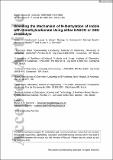Files in this item
Unveiling the mechanism of N‐methylation of indole with dimethylcarbonate using either DABCO or DBU as catalyst
Item metadata
| dc.contributor.author | Vendramini, Pedro H. | |
| dc.contributor.author | Zeoly, Lucas A. | |
| dc.contributor.author | Cormanich, Rodrigo A. | |
| dc.contributor.author | Buehl, Michael | |
| dc.contributor.author | Eberlin, Marcos N. | |
| dc.contributor.author | Ferreira, Bruno R. V. | |
| dc.date.accessioned | 2022-02-15T00:38:46Z | |
| dc.date.available | 2022-02-15T00:38:46Z | |
| dc.date.issued | 2021-02-15 | |
| dc.identifier | 272599708 | |
| dc.identifier | 94af553d-0610-4fd6-a3e0-85d22eec858c | |
| dc.identifier | 000630460700006 | |
| dc.identifier | 85101465873 | |
| dc.identifier.citation | Vendramini , P H , Zeoly , L A , Cormanich , R A , Buehl , M , Eberlin , M N & Ferreira , B R V 2021 , ' Unveiling the mechanism of N ‐methylation of indole with dimethylcarbonate using either DABCO or DBU as catalyst ' , Journal of Mass Spectrometry , vol. 56 , no. 3 , e4707 . https://doi.org/10.1002/jms.4707 | en |
| dc.identifier.issn | 1076-5174 | |
| dc.identifier.other | ORCID: /0000-0002-1095-7143/work/89178256 | |
| dc.identifier.uri | https://hdl.handle.net/10023/24874 | |
| dc.description | B.R.V.F., P.H.V. and M.N.E. acknowledge the São Paulo State Science Foundation (FAPESP) and the Brazilian National Science Council (CNPq) for financial support. L.A.Z. thanks CNPQ for his PhD scholarship (142476/2018-8), R.A.C. thanks SDumont and CESUP. M.B. thanks the School of Chemistry and EaStCHEM for support and for access to a computer cluster maintained by Dr. H. Früchtl. | en |
| dc.description.abstract | Depending on the catalyst used, N‐methylation of indole with dimethylcarbonate (DMC) ‐ an environmentally friendly alkylation agent – yields different products. With 1,4‐diazabicyclo[2.2.2]octane (DABCO), the reaction forms only N‐methylated indole but with or 1,8‐diazabicyclo[5.4.0]undec‐7‐ene (DBU), both N‐methylated and N‐methoxycarbonylated indole are formed. Using direct ESI(+)‐MS monitoring to collect actual snapshots of the changing ionic composition of the reaction solution, we report on the interception and characterization of key intermediates for such reactions. Although a mechanism has been proposed with methoxycarbonylated base as the key intermediate for both DBU and DABCO, the ESI(+)‐MS data as well as B3LYP‐D3/6‐311+G** calculations suggest that the reaction of DMC with indole under either DABCO or DBU catalysis follow contrasting mechanisms. | |
| dc.format.extent | 2497855 | |
| dc.language.iso | eng | |
| dc.relation.ispartof | Journal of Mass Spectrometry | en |
| dc.subject | Indole | en |
| dc.subject | ESI(+)-MS/MS | en |
| dc.subject | N-methylation | en |
| dc.subject | Mechanism | en |
| dc.subject | Density functional theory | en |
| dc.subject | QD Chemistry | en |
| dc.subject | DAS | en |
| dc.subject.lcc | QD | en |
| dc.title | Unveiling the mechanism of N‐methylation of indole with dimethylcarbonate using either DABCO or DBU as catalyst | en |
| dc.type | Journal article | en |
| dc.contributor.institution | University of St Andrews. School of Chemistry | en |
| dc.contributor.institution | University of St Andrews. EaSTCHEM | en |
| dc.identifier.doi | 10.1002/jms.4707 | |
| dc.description.status | Peer reviewed | en |
| dc.date.embargoedUntil | 2022-02-15 |
This item appears in the following Collection(s)
Items in the St Andrews Research Repository are protected by copyright, with all rights reserved, unless otherwise indicated.

